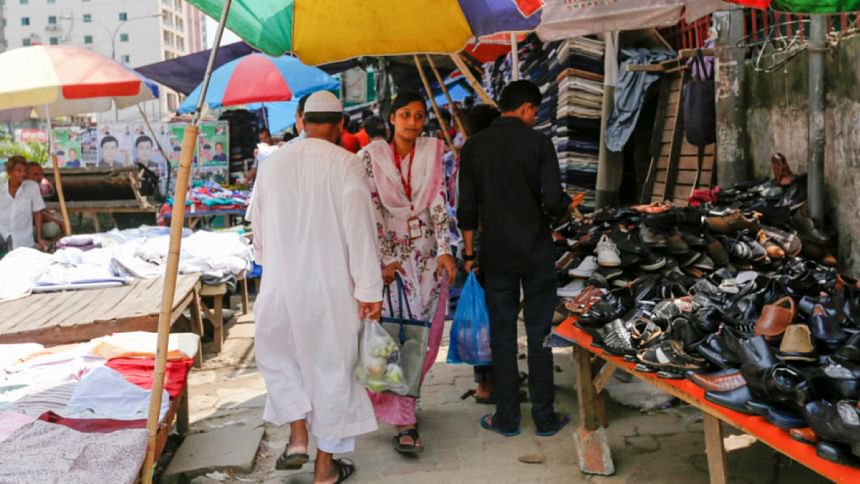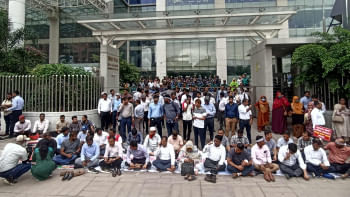Our footpaths need to be freed

The Detailed Area Plan (DAP) 2022-2035 outlines a grand vision of creating an "urban lifeline." The concept envisions a healthy urban dwelling revolving around footpaths. Citizens of metropolitan areas would be walking, cycling, jogging and even resting in benches set up along the footpath. The pathways would demonstrate a glimpse of urban lifestyles. Office-goers, school children, elderly citizens—people from all classes and ages would fill the footpaths with their vibrant presence. But this idea is far from how footpaths are being used at present.
It is a common sight that every footpath is densely occupied by small businesses. While some are temporary and mobile, others are extensions of large, permanent shops. Generally, hawkers and vendors of clothes, shoes, leather items, and accessories encroach the footpaths along primary roads. Vegetable and fruit sellers station themselves by secondary and tertiary roads. Sometimes, these businesses take over the left-most lanes too, leading to the disruption of traffic flow, as vehicles cannot gain speed.
What's more, the lanes are frequently used for parking cars. This effectively reduces the space for vehicular movement, and the gaps between parked cars invite more encroachers. While footpath vendors invite crowds, hindering pedestrian movement, frustrated pedestrians get off the footpath and intrude the road's left-most lane, leading to even more disruption. Urban aesthetics are also compromised. It's often observed that one side of the footpath houses permanent shops, while the other hosts hawkers and mobile vendors. Suffice to say, illegal occupation brings immense misery for city residents.
It is important to note that products and services provided by encroachers—like street food, books, toys, electronic accessories—are largely recreational in nature. Because these items are also available in dedicated markets nearby, albeit at a higher price, getting rid of this encroachment should not disrupt market mechanisms. Footpaths offer supply-induced demand. They function by attracting pedestrians going to attend some other business. Furthermore, these groups of sellers are not licensed. They don't pay taxes to the government but do financially patronise local influentials. Sellers in established markets and permanent shops pay high licence and other informal fees to stay operational, which for hawkers and mobile vendors on footpaths are conveniently lower. These economic incentives need to be addressed to resolve this issue.
It is high time authorities restored the city's aesthetics and footpaths' mobility by taking stern actions. For example, parking on the road must not be allowed and be met with stringent consequences.
It must be ensured that hawkers and mobile vendors cannot invade footpath space with ease. Stuck in traffic jams, bikers too intrude the footpaths to evade traffic. Guardrails along footpaths do a fantastic job of keeping bikers on the road without requiring any monitoring. They also prevent mobile vendors from taking over.
Building pedestrian shades is necessary to keep passengers from waiting on the road for transport. Benches could be built on the footpaths near bus stoppages for commuters. Frequent drives by the city corporation and law enforcement agencies should be conducted to keep encroachers off the pathways.
While it is true that encroachment benefits a certain group of people, it can also be argued that such opportunity to profit off footpaths is keeping them from exploring other business options. There are places in Dhaka where no such encroachment takes place, and livability of those areas is much better.
Encroachment-free footpaths do not necessarily eliminate the existence of mobile food carts or hawkers. Rather the new plan will ensure an organised and planned operation of such businesses, so as to not overcrowd the footpaths and compromise pedestrian mobility. At the same time, it attempts to achieve urban aesthetics. It's now on the authorities, who have the capacity, to monitor and eliminate illegal occupation.
Zulkernain Khandaker is an economics graduate from Dhaka University. He can reached at [email protected].
Views expressed in this article are the author's own.
Follow The Daily Star Opinion on Facebook for the latest opinions, commentaries and analyses by experts and professionals. To contribute your article or letter to The Daily Star Opinion, see our guidelines for submission.

 For all latest news, follow The Daily Star's Google News channel.
For all latest news, follow The Daily Star's Google News channel. 








Comments